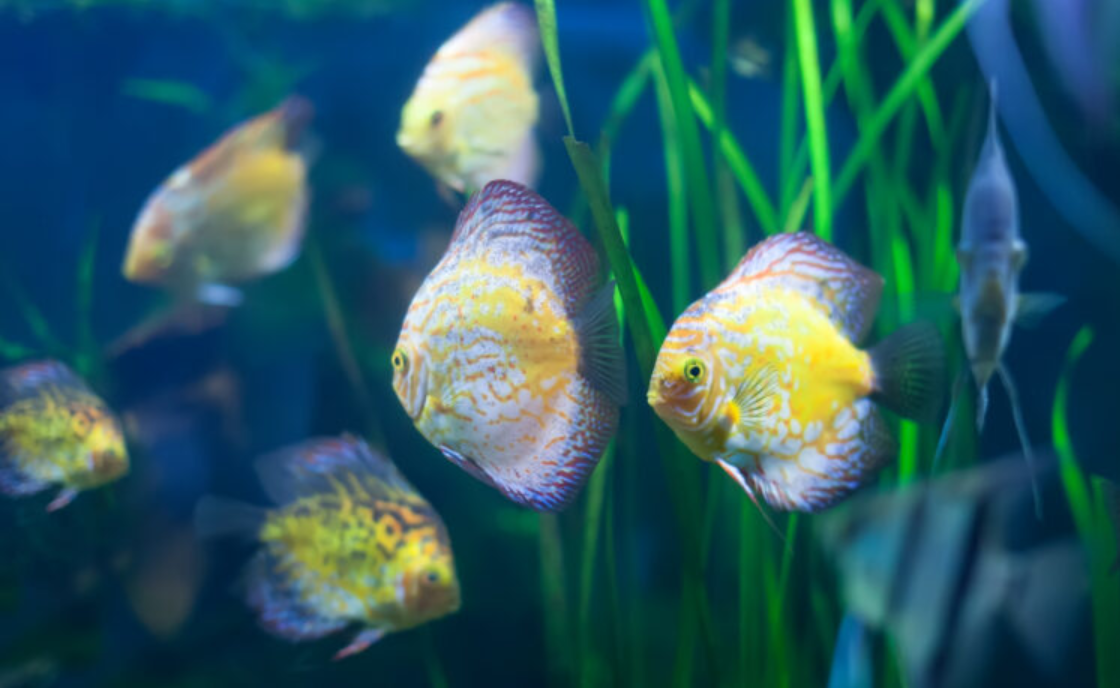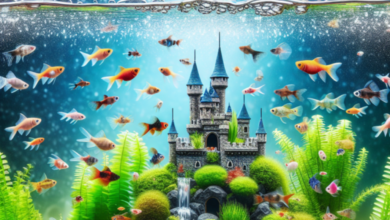Welcome to the ultimate guide to freshwater fish! If you’re a fish enthusiast or looking to dive into the world of aquariums, this article will provide you with everything you need to know about freshwater fish. From species profiles to care tips, we will cover all the essential aspects of keeping these aquatic creatures happy and healthy.
Key Takeaways:
- Freshwater fish are a popular choice for aquariums among fish enthusiasts
- Learning about different species and their unique care requirements is crucial for their well-being
- Setting up a suitable habitat is essential for the health and happiness of freshwater fish
- Proper nutrition and preventive health measures can help prevent common health issues
- Providing love, care, and attention to your freshwater fish can lead to a thriving and vibrant aquarium
Understanding Freshwater Fish: An Introduction
If you’re new to the world of freshwater fish, it’s essential to understand the basics before delving into specific species and care tips. So let’s start by defining freshwater fish.
“Freshwater fish” refers to fish that live in bodies of freshwater, such as rivers, lakes, and ponds. They differ from saltwater fish, which live in oceans and seas.
Freshwater fish come in all shapes, sizes, and colors, with varying habitats and requirements. Some common types of freshwater fish include catfish, tetras, cichlids, and goldfish.
Freshwater Fish Habitats
Freshwater fish inhabit a variety of environments, from fast-flowing rivers to stagnant ponds. Their habitat plays a crucial role in determining their needs and care requirements.
For example, a fish that originates from a river with strong currents will require a more powerful filter compared to a fish from a slow-moving pond. Similarly, fish that live in warm tropical waters need specific water temperatures and conditions to thrive.
Factors Affecting Freshwater Fish Well-Being
Several factors can impact the overall well-being of freshwater fish, including water quality, diet, and tank size.
Water quality is perhaps the most critical factor for maintaining healthy fish. The water in your aquarium must be free from pollutants and maintain appropriate pH, ammonia, and nitrate levels. Regular water changes and tank maintenance are crucial for ensuring optimal water quality.
Diet also plays an essential role in keeping your fish healthy. Different species have different dietary requirements, so it’s crucial to research and provide suitable food accordingly. Overfeeding is a common mistake that can lead to health problems, so it’s important to follow recommended feeding schedules and portion sizes.
Finally, the tank size is another significant factor that affects the well-being of your freshwater fish. Providing adequate space and hiding spots for your fish to explore and swim reduces stress and promotes overall health.
In Conclusion
Understanding the basics of freshwater fish is crucial for providing the best care for your aquatic companions. In the next sections, we will dive into specific species and care tips to help you build a thriving and vibrant freshwater fish aquarium.
Popular Freshwater Fish Species for Beginners
For those just starting out in the freshwater fish hobby, it’s crucial to choose species that are easy to care for and hardy. Here are some of the most popular freshwater fish species for beginners:
| Fish Species | Temperament | Size | Water Parameters |
|---|---|---|---|
| Guppies | Peaceful | 1-2 inches | Temperature: 72-82°F pH: 7.0-8.2 |
| Platies | Peaceful | 2-3 inches | Temperature: 70-78°F pH: 7.0-8.2 |
| Mollies | Relatively peaceful | 3-4 inches | Temperature: 72-78°F pH: 7.0-8.5 |
| Tetras | Peaceful | 1-2 inches | Temperature: 72-82°F pH: 6.0-7.5 |
| Cory Catfish | Peaceful | 2-3 inches | Temperature: 72-82°F pH: 6.5-7.5 |
These fish species are all relatively easy to care for, making them perfect for beginners. They also have peaceful temperaments, which means they can be kept together without too much risk of aggression.
It’s important to note, however, that even these beginner-friendly species require proper care and attention to ensure their health and well-being. Regular water changes, a balanced diet, and a suitable tank setup are all essential for keeping your freshwater fish healthy and happy.
Exotic Freshwater Fish Species: Uncovering Hidden Gems
If you’re looking to add a touch of uniqueness to your aquarium, exploring exotic freshwater fish species is a great option. In this section, we will uncover some lesser-known but stunningly beautiful species, discussing their care needs and compatibility.
Electric Blue Acara
The Electric Blue Acara is a stunning species that boasts a vibrant blue coloration. Native to South America, these fish are relatively peaceful and can be kept in community tanks. They thrive in slightly acidic water with plenty of hiding places and a varied diet consisting of high-quality flake food, pellets, and live or frozen foods. These fish can grow up to 6 inches in length and require a tank of at least 30 gallons.
Pearl Gourami
The Pearl Gourami is a peaceful and easy-to-care-for species that is native to Southeast Asia. These fish have a subtle, pearlescent coloration and can be kept in pairs or groups. They prefer slightly acidic water with a temperature between 77°F to 82°F and require plenty of hiding places such as plants or caves. The Pearl Gourami feeds on a varied diet of flake food, pellets, and live or frozen foods. These fish can grow up to 5 inches in length and require a tank of at least 20 gallons.
Cherry Barb
The Cherry Barb is a lively and colorful species that is native to Sri Lanka. These fish have a striking red coloration and can be kept in schools of at least six individuals. They prefer a slightly acidic water with a temperature between 72°F to 82°F and require plenty of swimming space and hiding places such as plants or driftwood. The Cherry Barb feeds on a varied diet of flake food, pellets, and live or frozen foods. These fish can grow up to 2.5 inches in length and require a tank of at least 15 gallons.
Did you know? The Cherry Barb gets its name from its bright red coloration, which resembles a cherry.
By adding these exotic freshwater fish species to your aquarium, you can create a unique and eye-catching display. Just remember to provide them with suitable care and a suitable environment to thrive in.
Creating the Perfect Freshwater Fish Aquarium
Building a suitable habitat is crucial for the health and happiness of your freshwater fish. Here are some setup tips to ensure that you create the perfect freshwater fish aquarium.
Tank Size
The size of your tank is a critical factor in determining the overall health of your freshwater fish. A larger tank allows more space for the fish to move around, reduces the likelihood of territorial disputes, and helps maintain stable water conditions. As a general rule, a 20-gallon tank is suitable for a single small species of fish, with an additional 10 gallons for each extra fish.
Water Parameters
Before adding fish to your aquarium, be sure to check the water parameters. Most freshwater fish require a pH level between 6.5 and 7.5, with a hardness level of 4-8 dGH. Proper filtration is essential for maintaining clean water, and you can also add live plants to help absorb nutrients and improve water quality.
Decorations
Decorations not only add aesthetic appeal to your aquarium but also provide hiding places and territory for your fish. When choosing decorations, consider the needs of your fish, such as providing caves and plants for hiding or improving water flow with rocks and driftwood. Avoid overcrowding the tank with decorations, as this can limit swimming space for the fish.
Lighting
Lighting is crucial for photosynthesis in live plants, which can help improve water quality and add visual interest to your aquarium. Additionally, lighting can influence the behavior and health of your fish. Be sure to research the lighting requirements of your specific fish species, and avoid over-exposure to light, as this can cause stress and harm to your fish.
Stocking and Compatibility
When choosing which fish species to add to your aquarium, it’s essential to consider compatibility. Avoid keeping aggressive or territorial species with peaceful ones, as this can result in harm or stress to the fish. Research the social and behavioral needs of each species to ensure that they can coexist peacefully in the same tank.
Summary
By following these setup tips, you can create a suitable and healthy home for your freshwater fish. Proper tank size, water parameters, decorations, lighting, and stocking decisions all contribute to the well-being of your fish. Remember, a happy and thriving aquarium requires dedication, patience, and attention to detail.
Feeding and Nutrition: Keeping Your Freshwater Fish Well-Fed
Feeding your freshwater fish is more than just a task; it’s an important responsibility to ensure their good health and well-being. To provide your fish with the necessary nutrients, you must understand their dietary requirements. Different species have different feeding needs, so it’s essential to choose the right food to avoid malnutrition, stunted growth, and other health issues.
Dietary Requirements of Freshwater Fish
Most freshwater fish are omnivorous, which means they consume both animal and plant-based food. Some species are herbivorous, while others are carnivorous.
Tip: Research the specific dietary needs of your fish species to determine the right balance of protein and other nutrients they require.
Generally, fish food falls into three main categories: flakes, pellets, and frozen or live food. Each type has its own advantages and disadvantages.
- Flake food: This is the most common type of fish food, consisting of a mixture of ingredients that form flakes. Flakes are easy to use, have a long shelf life, and come in a wide range of formulas to meet different dietary requirements. However, they can leave a residue in the water and may not always be suitable for certain fish species.
- Pellet food: Pellets are made from compressed ingredients and come in various sizes, depending on the size of your fish. They are more nutrient-dense than flakes and don’t leave much residue in the water. However, they can be pricey and may not be suitable for all fish types.
- Frozen or live food: These are the most natural types of food and provide the highest quality nutrition. Frozen food can be stored for a long time, while live food provides a stimulating hunting experience for your fish. However, they require more work and can be expensive.
How Often to Feed Your Freshwater Fish
The feeding frequency of your freshwater fish depends on their species, age, and size. Some fish are grazers and require several small meals throughout the day, while others are more comfortable with one or two substantial meals. Overfeeding your fish can lead to health problems, while underfeeding can cause malnutrition.
- Adult fish: Feed your adult fish once or twice a day, with a portion size that they can consume in a few minutes. Avoid overfeeding, as uneaten food can decompose and create health issues for your fish.
- Juvenile fish: Young fish require more frequent feeding, with smaller portions throughout the day. Feed them three to four times a day, according to their size and species.
- Fasting: Fasting your fish for a day once a week is essential to maintain a healthy digestive system and reduce the risk of constipation or bloating.
Supplementing Your Freshwater Fish’s Diet
While commercial food is a convenient and safe option for your freshwater fish, it’s essential to supplement their diet with fresh vegetables and live food occasionally. Vegetables like peas, lettuce, spinach, and cucumber provide essential nutrients, and live food like brine shrimp, daphnia, and mosquito larvae offer alternative protein sources.
Remember that nutrition is vital for your freshwater fish’s growth, coloration, and overall health. By understanding their dietary requirements and feeding them accordingly, you can ensure their optimal well-being and enjoy a healthy and vibrant aquarium.
Common Health Issues and Their Remedies for Freshwater Fish
While freshwater fish are generally hardy and easy to care for, they can sometimes develop health issues. It’s essential to keep a watchful eye on your aquatic pets, regularly checking for any signs of illness. Below are some common health issues that freshwater fish may face, along with potential remedies:
- Fungal Infections: These infections are often caused by poor water quality or overcrowding. Symptoms include white or gray cotton-like patches on the fish’s body or fins. To remedy fungal infections, treat the aquarium with a fungicide and address any underlying issues with water quality or tank size.
- Ich: This is a parasitic infection that manifests as small white dots on the fish’s body or fins. Symptoms also include rubbing against objects and gasping at the surface of the water. To treat ich, raise the water temperature to 86°F and introduce medication to the aquarium. It’s important to also address any underlying issues with water quality or tank size.
- Swim Bladder Disease: This condition affects a fish’s ability to control its buoyancy, causing it to float or sink uncontrollably. It is often caused by overfeeding, constipation, or injury. To remedy swim bladder disease, withhold food for a few days and consider feeding peas (with the skin removed) to help with digestion. If the condition persists, consult a veterinarian or an experienced aquatic veterinarian.
- Viral Infections: Viral infections in freshwater fish are often difficult to detect and treat. Symptoms may include loss of appetite, abnormal swimming behavior, or discolored patches on the fish’s skin. To prevent viral infections, maintain a clean and healthy environment for the fish, including regular water changes and adequate filtration. If you suspect a viral infection, isolate the infected fish and consult a veterinarian or an experienced aquatic veterinarian.
- Parasites: Parasites such as flukes, anchor worms, and lice can cause significant damage to freshwater fish. Symptoms include excess mucus on the fish’s body or fins, scratching against objects, and loss of appetite. To treat parasite infections, introduce medication to the aquarium and maintain a clean and healthy environment. Quarantine any infected fish and treat them separately to prevent the spread of parasites.
Regular monitoring and maintenance of your freshwater fish and their environment is crucial for preventing and addressing any potential health issues. By staying vigilant and seeking assistance when necessary, you can ensure the long-term health and happiness of your aquatic companions.
Conclusion
Congratulations! You’ve reached the end of our ultimate guide to freshwater fish. We hope you’ve enjoyed our comprehensive coverage of various species and expert care tips. Armed with this knowledge, you’re now ready to create a thriving aquarium and provide the best possible care for your freshwater fish.
The Importance of Love and Care
Remember, when it comes to your freshwater fish, providing love, care, and attention is crucial for their well-being. Your aquatic companions have unique personalities and habits, so take the time to observe their behavior and cater to their needs.
Continued Learning
Finally, we encourage you to keep learning about freshwater fish and their habitats. By expanding your knowledge, you can give your pets an even better life and appreciate their beauty even more.
Thank you for joining us on this journey, and happy fishkeeping!
FAQ
What water parameters are important to monitor for freshwater fish?
It is important to regularly monitor the temperature, pH level, ammonia, nitrate, and nitrite levels in your aquarium to ensure a healthy environment for your freshwater fish.
How often should I feed my freshwater fish?
The frequency of feeding will vary depending on the species of freshwater fish. As a general rule, feed your fish small amounts 2-3 times a day, ensuring they consume the food within 2-3 minutes.
How can I prevent common diseases in my freshwater fish?
To prevent common diseases in your freshwater fish, ensure you provide them with a well-maintained and clean environment, proper nutrition, and avoid introducing sick fish into your aquarium. Regular water changes and quarantine procedures for new fish can also help prevent the spread of diseases.
How can I create a natural-looking aquarium for my freshwater fish?
To create a natural-looking aquarium, consider adding live plants, driftwood, rocks, and other natural decorations. Mimicking the natural habitat of your fish will not only enhance the aesthetic appeal but also provide places for them to hide and explore.
Can different species of freshwater fish be kept together?
Yes, but it’s important to research the compatibility of different species before introducing them to the same aquarium. Some species may exhibit aggression towards others or have specific water parameter requirements that differ from other fish.




